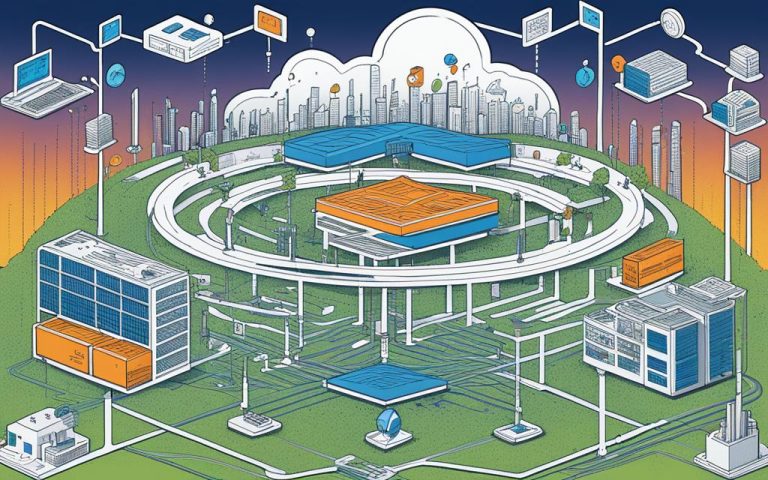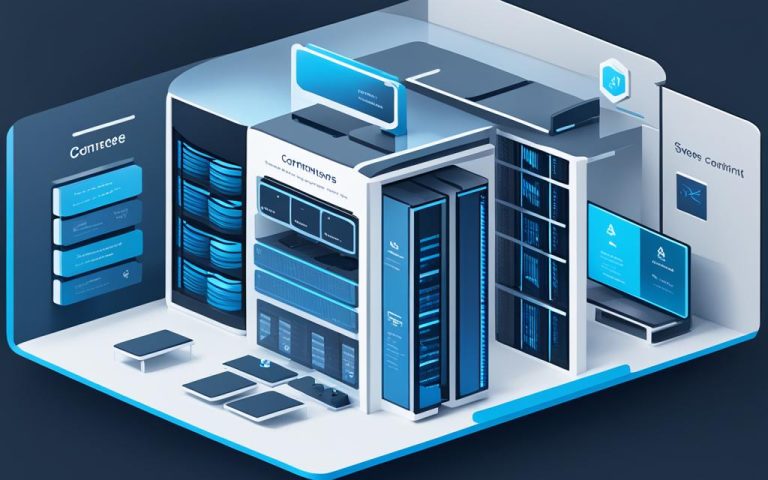Welcome to our comprehensive guide on Cloud Network Architecture fundamentals. In today’s digital landscape, organizations are increasingly embracing cloud computing platforms for their scalability, flexibility, and cost-effective solutions. However, to harness the full potential of the cloud, it is crucial to understand the key principles that underpin cloud network architecture.
In this introductory guide, we will explore the five pillars that form the foundation of cloud network architecture: operational excellence, reliability, security, performance efficiency, and cost optimization. By mastering these principles, development teams can build robust and efficient cloud-based applications that meet the demands of modern businesses.
Throughout this guide, we will delve into each pillar individually, providing insights and best practices to help you design and implement a scalable and resilient cloud architecture. From automating deployments and managing workloads to implementing disaster recovery procedures and optimizing performance, we will cover all the essential aspects of cloud network architecture.
Whether you are new to cloud computing or looking to enhance your existing cloud infrastructure, this guide is your go-to resource for understanding the fundamental concepts and practices that drive cloud network architecture. So let’s dive in and unlock the full potential of cloud computing for your organization!
Operational Excellence in Cloud Architecture
Operational Excellence is a crucial aspect of cloud architecture that focuses on achieving efficient deployment, operation, monitoring, and management of cloud workloads. By implementing best practices such as automation, infrastructure as code, and efficient workload management, teams can optimize their operational processes and enhance overall operational efficiency in the cloud.
Effective deployment and management of cloud workloads require automation and streamlined processes. By automating deployments, teams can eliminate manual errors, reduce deployment time, and ensure consistent and repeatable processes. This can be achieved by utilizing Infrastructure as Code (IaC) tools such as Terraform or CloudFormation, which enable teams to define their infrastructure as code and provision resources programmatically.
Monitoring and alerting systems are essential in ensuring the smooth operation of cloud workloads. By implementing robust monitoring and alerting systems, teams can proactively identify and address potential issues, ensuring optimal performance and availability. This includes setting up comprehensive dashboards, configuring threshold-based alerts, and leveraging cloud-native monitoring services like Amazon CloudWatch or Azure Monitor.
Managing capacity and quotas is another critical aspect of operational excellence. By effectively managing capacity, teams can avoid resource shortages or over-provisioning, ensuring cost optimization and optimal performance. This can be achieved through proactive capacity planning, utilizing auto-scaling capabilities, and leveraging cloud provider tools and services for resource optimization.
Automation plays a vital role in achieving operational excellence in the cloud. By automating processes such as environment provisioning, configuration management, and repetitive tasks, teams can free up valuable resources and focus on strategic initiatives. This can include using tools like Ansible, Puppet, or Chef for configuration management or leveraging cloud provider-specific automation services like AWS Lambda or Azure Functions.
Knowledge management resources are instrumental in maintaining operational excellence. By documenting processes, best practices, and lessons learned, teams can ensure knowledge continuity and facilitate effective collaboration. This can include establishing a centralized knowledge base or utilizing collaboration tools like Confluence or Microsoft Teams.
Benefits of Operational Excellence in Cloud Architecture
Implementing operational excellence practices in cloud architecture can yield several benefits, including:
- Improved efficiency and productivity
- Reduced manual errors and improved consistency
- Enhanced scalability and flexibility
- Cost optimization through resource management
- Increased system availability and performance
By embracing operational excellence principles and leveraging automation and efficient workload management, teams can achieve streamlined processes, improved performance, and enhanced overall operational efficiency in the cloud.
Reliability in Cloud Architecture
Reliability is a crucial aspect of cloud architecture, ensuring that applications and systems are available and perform consistently. By implementing resilient system design and disaster recovery procedures, teams can minimize downtime and provide a reliable experience for users.
Resilient System Design
Resilient system design involves designing cloud-based applications in a way that allows them to withstand failures and continue operating seamlessly. One key practice is deploying resources across multiple regions, spreading the workload to ensure high availability. This ensures that even if one region experiences an outage, the application can still function without interruption.
Horizontal scaling is another important aspect of resilient system design. By distributing the workload across multiple instances, the system can handle increased traffic and automatically scale to meet demand. This ensures that the application remains responsive and available even during peak usage periods.
Disaster Recovery
Disaster recovery procedures are essential for quickly recovering from system failures or disasters. By automating recovery processes and leveraging cloud capabilities, teams can minimize downtime and prevent data loss. This includes regularly backing up data and configurations, implementing robust backup and restore mechanisms, and conducting periodic disaster recovery drills to ensure readiness in case of an actual incident.
Monitoring and alerting for system health is also crucial in ensuring reliability. By continuously monitoring the performance and health of the cloud-based systems, teams can proactively identify and address issues to prevent downtime. Real-time alerts enable immediate action to be taken, reducing the impact of potential failures.

In conclusion, reliability in cloud architecture is achieved through resilient system design and disaster recovery procedures. By deploying resources across multiple regions, automating recovery processes, and implementing monitoring and alerting systems, teams can ensure the reliability of their cloud-based applications. Building a reliable system not only enhances user experience but also helps businesses mitigate the impact of potential failures and ensure continuous operation.
Security in Cloud Architecture
Security is a critical aspect of cloud architecture. Ensuring the protection of data, workloads, and network infrastructure is of utmost importance to organizations. By implementing robust security measures, teams can confidently leverage the benefits offered by cloud computing. In this section, we will explore key practices and strategies for achieving comprehensive security in cloud-based systems.
Securing Data and Workloads
One of the fundamental elements of cloud security is data encryption. By encrypting sensitive information at rest and in transit, organizations can prevent unauthorized access and protect valuable assets. Implementing encryption mechanisms such as SSL/TLS and data encryption at the application level ensures data confidentiality and integrity.
Applying Security at All Layers
Securing cloud infrastructure requires a multi-layered approach. Implementing security measures at every level, including the physical data centers, the hypervisor layer, the operating system, and the application layer, strengthens the overall security posture. By adopting a defense-in-depth strategy, organizations can safeguard against various types of threats and vulnerabilities.
Implementing Security Monitoring and Logging
Continuous security monitoring and logging play a crucial role in detecting and responding to security incidents in real-time. By implementing automated monitoring tools and establishing robust logging practices, organizations can gain visibility into their cloud environments and identify any suspicious activities or potential breaches.
Enforcing Network Segmentation and Access Control
Network segmentation is a vital security measure that involves dividing the cloud infrastructure into isolated segments or virtual networks. Implementing strict access control policies, including firewall rules, network ACLs, and virtual private networks (VPNs), ensures that only authorized users and services can access specific resources, minimizing the risk of unauthorized access.
Managing User Access with IAM
Identity and Access Management (IAM) solutions provide granular control over user access to cloud resources. By implementing user roles, permissions, and strong authentication mechanisms, organizations can effectively manage user access privileges, reducing the chances of unauthorized access or privilege escalation.
Implementing Multi-Factor Authentication
Utilizing multi-factor authentication adds an extra layer of security by requiring users to provide additional verification steps, such as a one-time password or biometric identification, in addition to their regular login credentials. This helps prevent unauthorized access, even if login credentials are compromised.
Continuously Updating Security Measures
Cloud security is an ongoing process that must adapt to evolving threats and vulnerabilities. Regularly updating security measures, including patch management, software updates, and security configurations, helps organizations stay one step ahead of potential risks and ensures that their cloud-based systems are protected against the latest security threats.
| Security Best Practices | Benefits |
|---|---|
| Implement data encryption at rest and in transit | Protects sensitive data from unauthorized access |
| Apply security measures at all layers of cloud infrastructure | Strengthen the overall security posture |
| Implement security monitoring and logging | Enables real-time detection and response to security incidents |
| Enforce network segmentation and access control | Minimizes the risk of unauthorized access |
| Manage user access with IAM | Efficiently control user privileges and access |
| Implement multi-factor authentication | Enhances authentication security |
| Continuously update security measures | Stay protected against emerging security threats |
Performance Efficiency in Cloud Architecture
Performance efficiency is a crucial aspect of cloud architecture that focuses on designing and optimizing resources to achieve optimal performance. By effectively monitoring and analyzing performance metrics, teams can identify potential bottlenecks and areas for improvement. This allows them to make informed decisions when it comes to right-sizing resources, ensuring that each component of the cloud infrastructure is efficiently utilized.
In addition to resource monitoring, optimizing storage performance is essential in maximizing performance efficiency. Teams can employ various techniques, such as employing caching mechanisms, implementing data transfer optimizations, and leveraging compression methods. These strategies help reduce storage latency and enhance data retrieval speed, ultimately improving overall application performance.
To anticipate varying workloads and ensure seamless scalability, teams need to anticipate load patterns and employ auto-scaling techniques. By monitoring application usage and demand, teams can dynamically scale resources up or down, optimizing performance and avoiding unnecessary resource allocation. This approach ensures that the application can handle sudden spikes in traffic without compromising performance or user experience.
Furthermore, the adoption of microservices architecture significantly contributes to performance efficiency in cloud environments. Microservices allow for the development of applications as a collection of small, independent services that communicate over well-defined APIs. This architecture enables individual services to be scaled independently, improving resource utilization and facilitating faster deployment cycles. By breaking down applications into microservices, cloud architectures can achieve greater agility, resilience, and scalability, aligning perfectly with the principles of performance efficiency.
Optimizing network communication is vital for performance efficiency in a cloud architecture. Teams can optimize network traffic by minimizing latency, reducing data transfer overhead, and utilizing content delivery networks (CDNs) to deliver content efficiently. These strategies help enhance application responsiveness and improve the overall user experience.
FAQ
What are the key aspects of cloud network architecture?
The key aspects of cloud network architecture include operational excellence, reliability, security, performance efficiency, and cost optimization.
What is operational excellence in cloud architecture?
Operational excellence in cloud architecture refers to efficiently deploying, operating, monitoring, and managing cloud workloads. This includes automating deployments, utilizing Infrastructure as Code tools, implementing monitoring and alerting systems, managing capacity and quotas, automating processes, and maintaining knowledge management resources.
What does reliability in cloud architecture involve?
Reliability in cloud architecture focuses on designing resilient and highly available systems. This includes deploying resources across multiple regions, automating recovery from failures, implementing disaster recovery procedures, monitoring and alerting for system health, scaling horizontally, and utilizing cloud capabilities for replication.
Why is security important in cloud architecture?
Security is a critical aspect of cloud architecture as it involves securing data and workloads, applying security at all layers, implementing security monitoring and logging, enforcing network segmentation and access control, managing user access with IAM, implementing multi-factor authentication, and continuously updating security measures.
How can performance efficiency be achieved in cloud architecture?
Performance efficiency in cloud architecture can be achieved by designing and tuning resources for optimal performance. This includes monitoring and analyzing performance, right-sizing resources, optimizing storage performance, anticipating load and scaling, utilizing best practices such as caching and data transfer optimizations, and optimizing network communication.



















